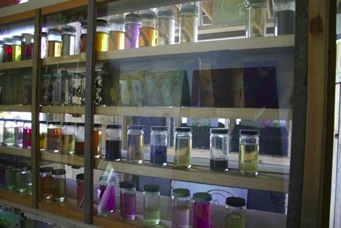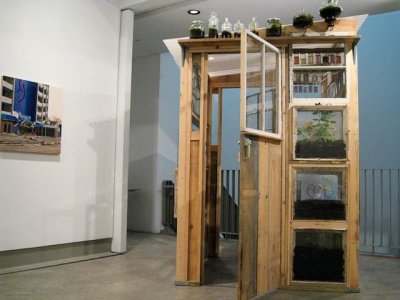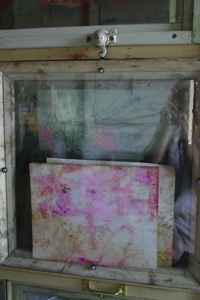 Alison Williams, Glasshouse #3 (detail), 2010. Wood, glass, flower juice.
Alison Williams, Glasshouse #3 (detail), 2010. Wood, glass, flower juice.
At the eighth annual Joan Mitchell MFA Award Exhibition held at the CUE Art Foundation in New York City, a glass and wood structure entitled Glasshouse #3 by Alison Williams (MFA, Art Institute of Boston, 2009) stands out for its creation of an intimate space carved out of the gallery environment, an interior within an interior that turns viewers into participants in a deeply resonant environment referencing the garden. The architectural space within space is echoed in the many dualities that emerge through the viewer’s multi-sensory interaction with the work.
 Alison Williams used found glas and wood to create this elaborate structure that defines its own architectural space within the gallery setting.
Alison Williams used found glas and wood to create this elaborate structure that defines its own architectural space within the gallery setting.
Taking as a starting point the relationship between her art and the garden, Williams uses a technique she refers to as “evidencing.” Williams’ own garden becomes a primary site of inquiry in which she works with a variety of media, including a large amount of found glass, to explore the garden’s contours and possibilities. This includes burying materials in the ground and allowing the soil to impress itself upon them. At the end of a certain period, she collects together photographs, paintings, drawings, and so on, as “evidence” of her exploration, and these become the artist’s finished works.
 In Glasshouse #3 (2010), the materials worked with in the garden are repurposed windows, repurposed glass shelves, wood, bottles, plant matter, and mixed media. An important element of the work seems to be the notion of preservation, and specifically a discovery of preserved elements, of memory itself.
In Glasshouse #3 (2010), the materials worked with in the garden are repurposed windows, repurposed glass shelves, wood, bottles, plant matter, and mixed media. An important element of the work seems to be the notion of preservation, and specifically a discovery of preserved elements, of memory itself.
In the first place, the structure encloses and preserves an “other” space, an intimate and calm one. But this is just the first of many layers of preservation. Plants, bottles, and paintings encased in glass shelves cover the walls. Adorning the outside of the house are bottles containing “flower juice,” as well as glass cupboards with various decaying and tarnished media inside arranged to suggest a forgotten archive, at once organic and saturated with a nostalgic wistfulness.
This blending of the purely organic and the eminently meaningful gives way to the tension at the heart of memory, at the twin poles of the flow of time and the desire to remember, which can be thought of as an effort to preserve, or protect, memories from time.
It is here that the role of glass as protector comes to the fore by enclosing, but also as that which allows for viewing, which literally brings memory to light. In this duality of enclosure or stowing-away and visibility, glass appears as the mediator between inside and outside, between privacy and publicity, between the public gallery and the private garden.
—Lee Gaizak Brooks
IF YOU GO:
The Joan Mitchell Foundation 2009 MFA Grant Recipients Show June 10th – July 31st, 2010 CUE Art Foundation 511 West 25th St., Ground Floor New York, New York 10001 Tel: 212-206-3583 Website: www.cueartfoundation.org

